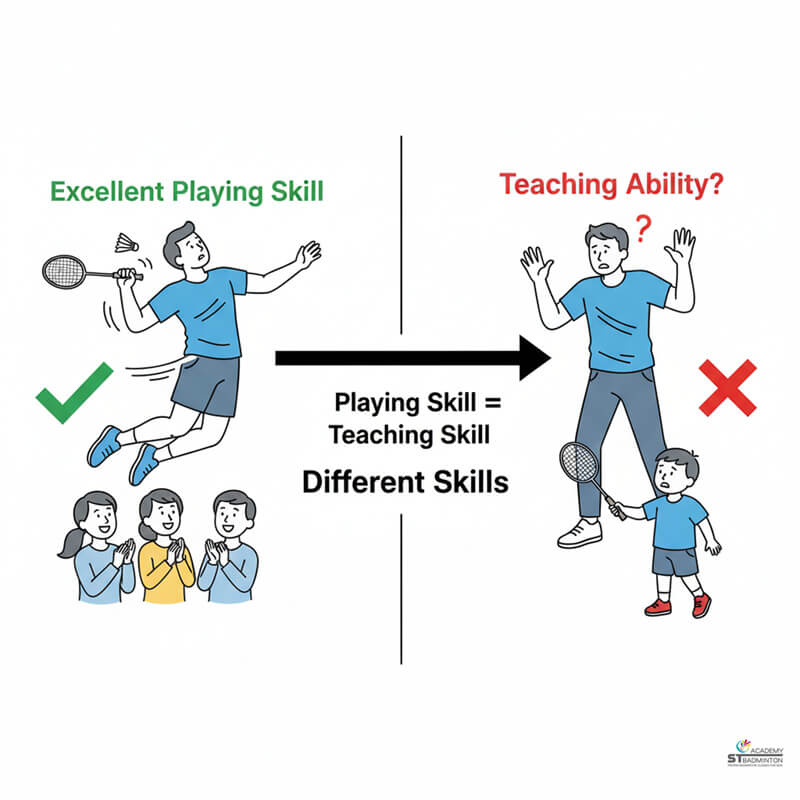Welcome to ST Badminton Academy’s badminton training in Malaysia! I’m always looking for new ways to help my athletes improve their balance and stability. Badminton is an incredibly dynamic sport that requires agility and coordination in order to be successful on the court, so having great balance and stability can give players a real edge over their opponents. In this article, I’ll share some of my top tips on how you can use badminton training to boost your balance and stability skills – read on to find out more!
Dynamic Balance Drills
I’m often asked how badminton training can help people improve their balance and stability. The answer is that there are a number of drills you can do to focus on dynamic balance. Power skips, shuttle runs and other movement-based exercises will all give your body the challenge it needs to stay balanced while also building strength.
Power skips involve jumping over a rope that has been laid out in an alternating single-double pattern. This exercise helps build power and agility as well as improve coordination by working on both sides of your body simultaneously – great for strengthening muscles associated with keeping your balance steady! Shuttle runs require running back and forth between two points, forcing you to quickly adjust direction without losing speed or control. As such, they become an ideal way to practice changing directions safely and efficiently.
Badminton players need strong core muscles if they want to play at their best. To strengthen them, you’ll need to move onto core strength exercises like planks, bridges, and squats. These movements target specific muscle groups so you can really hone in on what areas of your body need more work when it comes to maintaining good posture and form during physical activities. Next up we’ll look at some of these key core strength moves…
Core Strength Exercises
In order to improve balance and stability through badminton training, one must focus on core strength exercises. Exercises like planks and mountain climbers are anachronistic classics that will create a strong foundation for every movement required during a game of badminton. It is also beneficial to use more specific tools such as:
- Stability Ball:
- Strengthens the muscles in your abdomen, back, arms, wrists, hips, and legs.
- Improves flexibility by stretching out major muscle groups.
- Balance Board:
- Enhances coordination & proprioception (awareness of where parts of your body are).
- Improves overall posture.
With these two pieces of equipment, you can isolate individual muscles while challenging yourself with unique movements. In addition to strengthening targeted areas, this type of exercise provides great cardiovascular benefits while improving agility and reaction time— key components when playing badminton at any level. As you progress in your badminton training journey it’s important to develop core strength so that you have increased control over each shot and movement made on the court. Agility training is the next step in reaching optimal levels of performance while maintaining good form. Other than choosing a good racket and also remember to choose the best racket restring in Malaysia.
Agility Training
Badminton training can be an effective way to improve balance and stability. Agility is a key component of badminton and helps players stay on their feet, move quickly and make changes in direction efficiently. By incorporating agility drills into your training routine, you can develop the coordination and balance needed for success in matches.
| Drill | Description | Benefits |
|---|---|---|
| Run back and forth between markers placed 10-20 meters apart as fast as possible. Change directions at each marker by cutting sharp angles or doing a shuffle step | Run back-and-forth between markers placed 10-20 meters apart as fast as possible. Change directions at each marker by cutting sharp angles or doing a shuffle step | Improve acceleration, deceleration, reaction time, hand-eye coordination, and lateral movement |
| Step hops | Stand with one foot forward while keeping the other leg straight behind you. Hop from side to side onto the opposite foot without touching down with both feet at any given moment | Develop speed, increase power generation capabilities, and promote better body control when moving laterally |
| Lateral bounds with hurdles or cones | Set up two lines of 4-6 hurdles or cones about 30 cm tall that are spaced out 20 cm apart. Quickly jump left then right over each hurdle/cone going as far sideways as possible before changing direction | Shuttles sprint |
By regularly performing these drills during practice sessions, you will become more agile on the court which enhances your ability to maintain good balance and stability while playing badminton. Additionally, such exercises also help improve your overall athleticism which has many benefits outside of badminton like increased endurance and improved muscular coordination. To sum it up: agility training through shuttles sprints, step hops and lateral bounds with hurdles or cones should be incorporated into your badminton training regimen if you want to get better at maintaining balance and stability on court. Plyometrics is another great option for taking your game to the next level!
Plyometrics
Sure, badminton may seem like a game of agility and quick reflexes, but balance and stability are just as important for success. With the right training plan in place, you can improve your balance and stability through badminton training to become an even better player. I know what you’re thinking – how is that possible? Well, it all comes down to effective plyometrics exercises combined with resistance training and dynamic stretching drills.
Plyometric exercises increase muscular power by using fast movements such as jumps or hops. These movements help engage multiple muscle groups at once which not only improves coordination but also strengthens muscles while improving overall speed and agility.
Resistance training will help build strength in key areas such as the legs, core, arms, back, etc., while dynamic stretching exercises add flexibility and range of motion to those same areas. When done correctly together these three methods help create the perfect level of balance needed for improved performance on court.
To get the most out of your workout routine make sure to set aside time for both cardio work and specific drills designed for balance improvement. Focusing on single leg balances whilst incorporating lateral movement helps develop proper footwork techniques that can be adapted into actual game situations making them easier to execute during matches. From here we move onto…
Footwork Drills
Badminton training can be an effective way to improve balance and stability. The key lies in proper footwork drills, stroke mechanics, and shot selection. By developing good habits with your feet first, you can learn to stay balanced while you move around the court.
| Here are four essential footwork drills that will have a huge impact on your balance: |
|---|
| – Side-to-side steps: |
| – Moving from side to side quickly helps build agility and coordination. |
| – Forward/backward jogging: |
| – Focusing on keeping one foot out in front of the other is key for improving lateral quickness. |
| – Jumping rope: |
| – Not only does this drill help with overall conditioning, but it also teaches how to land softly after each jump. |
| – Balance exercises: |
| – Standing still with arms raised or standing on one leg are great ways to challenge yourself and work on staying steady during play. |
| Incorporating these footwork drills into your training routine will not only enhance your balance but also contribute to improved agility, coordination, and overall performance on the badminton court. |
By learning these basic techniques through badminton training, you’ll soon find yourself feeling more confident when playing rallies due to improved control over your body movements. Now let’s take a look at some simple isometric exercises that target specific muscles used in badminton!
Isometric Exercises
As I discussed in the previous section, footwork drills can be a great way to improve your balance and stability. However, if you really want to take it up a notch, isometric exercises are an incredible tool for this purpose. Isometrics will not only help with balance and stability but also strength and power!
Isometric holds require minimal equipment; just find yourself something sturdy like a wall or railing that won’t move when you press against it. Start by standing tall next to the object of choice and pressing one hand against it while pushing away from the surface as hard as possible. Hold this position for 10-30 seconds then switch sides and repeat. If you have access to resistance bands at home, these make excellent tools for isometric exercises too – simply attach one end of the band around an immovable object and hold onto the other end for 30 seconds before switching sides.
No matter which type of exercise you do, focus on keeping your core engaged throughout each rep so that all of your muscles work together in unison. This will ensure that whatever movement you practice has the maximum impact on improving both your balance and stability!
Single Leg Balance Drills
I’m a big believer in single-leg balance drills for badminton training. They help strengthen your body and improve your balance and stability, which is essential to success in badminton. Balancing on one leg can be a challenge, but with practice, you can build up your coordination and stability. With some patience and dedication, you can see a huge improvement in your balance and stability with single-leg balance drills.
Single Leg Balance Drills
Single-leg balance drills are key to improving your badminton game and overall fitness. They help you develop the control and stability needed to stay on your feet while playing, as well as provide an excellent core workout. Balance drills require you to stand on one foot in various positions for a period of time, which challenges muscles throughout the body that may not get much attention during regular workouts or games. You can use these exercises to improve your balance and stability significantly over time.
To begin, start with basic single-leg balancing exercises such as standing on one foot without holding onto anything for 30 seconds at a time. Once this becomes comfortable, progress by closing your eyes or raising one arm out in front of you. This will provide a greater challenge for both your balance and stability drills. Additionally, try lateral finger-tip touches along with hopping forward, backward, and side-to-side from one foot to the other – all great ways to build up strength and coordination while training badminton skills related to balance and stabilization.
Dynamic exercises are also beneficial when it comes to training balance and stability because they force you to react quickly, like stepping back into lunge position after jumping off one foot. Squat jumps combined with dynamic toe taps (jumping up onto platforms) can be used safely outdoors or indoors depending on the available space; either way they’re surefire ways to increase your overall agility while building strong legs essential for successful badminton play!
Balancing On One Leg
Balancing on one leg is an important skill for any badminton player to master. It not only helps you stay stable and control your movements, but it also provides a great core workout. To really challenge yourself with single-leg balancing exercises, try adding bodyweight squats or using a balance board. These will help increase the difficulty level and build strength in your legs – which can be essential for success during games. Plus, they’re fun too! Just make sure to start slow and work up your way as you become more confident in your abilities. Ultimately, these drills are key to improving both your badminton game and overall fitness; so give them a go today!
Plyo Pushup Variations
I’m going to show you how badminton training can improve your balance and stability. Plyo pushup variations are a great way to do this. These exercises work by engaging multiple muscles at once, which helps build strength and boost stability in the entire body. You can start with basic plyometric circuits like rotational jumps or lateral hops before moving on to more complex movements such as jump squats and mountain climbers.
For even greater results, add weighted objects into the mix. This will challenge your coordination skills while also building up explosive power and stability simultaneously. Try using lightweight dumbbells or kettlebells for added resistance during these types of exercises – just make sure that you keep proper form throughout each rep!
You’ll be amazed at what adding a few simple moves like these can bring to your overall performance in badminton. Not only will it help increase speed and agility but it can also provide an extra layer of protection against injuries due to improved balance and stability. So give them a try today; I guarantee you won’t regret it!
Frequently Asked Questions

What Is The Best Way To Warm Up Before Badminton Training?
When it comes to badminton training, the best way to warm up is by focusing on correct technique and mental focus. Start with dynamic stretching exercises such as lunges, leg swings, and arm circles. This will help loosen up your muscles and joints so you can move more freely during the workout. After that, do some light jogging or jumping rope for five minutes to get your heart rate up and ready for exercise.
Finally, practice a few shots using proper form and concentration – this helps build muscle memory while also mentally preparing yourself for the upcoming session. Warming up correctly before each badminton training session is essential to ensure an efficient and safe workout!
How Long Should Badminton Training Sessions Last?
If you’re looking for the perfect length badminton training session, then look no further! Generally speaking, sessions should last around 45 minutes to an hour. That may seem short, but trust us; it’s enough time to get those coordination drills and agility drills in while still leaving a little energy in your tank.
Plus, this way you’ll be able to stay focused on the task at hand – getting better with every practice session! So don’t overwork yourself; take some breaks during your training sessions if needed and remember that quality is better than quantity when it comes to badminton training.
What Type Of Footwear Is Best For Badminton Training?
When it comes to selecting the right footwear for badminton training, safety should be your top priority. Make sure you choose shoes that provide appropriate support and cushioning.
Look for a shoe with a flat non-marking sole designed specifically for court sports such as badminton. Avoid running or basketball-style shoes as they don’t provide proper grip on the court surface and could lead to slips and falls. I also recommend finding shoes made of breathable material like mesh so your feet stay cool during long sessions.
How Often Should I Be Incorporating Badminton Training Into My Regular Routine?
For badminton players who want to take their game to the next level and develop a strong foundation of balance and stability, incorporating regular plyometric drills and core strength training into their routine is essential.
To maximize results, aim for at least two or three days per week dedicated solely to these types of workouts in combination with an ongoing practice schedule. Doing this will allow you to build up your endurance, agility, flexibility, coordination, and overall power while helping you achieve optimal performance on the court. Badminton training can be a great way to stay active and have fun – so don’t forget about it!
What Other Activities Or Exercises Can Help To Improve My Balance And Stability?
If you’re looking to improve your balance and stability, there are a few great exercises that can help. Incorporating some cardio exercises into your regular routine is one way to get started – jogging or running for around 30 minutes several times a week will certainly help! Additionally, adding yoga poses like tree pose and warrior III can also be very beneficial.
They’ll help strengthen the muscles needed to maintain good posture and balance while playing badminton. Lastly, don’t forget about core strengthening exercises as they can also help with improving both balance and stability.
Train Balance and Stability with Professional Badminton Coach in Singapore
Badminton training is a great way to improve your balance and stability. It requires concentration, physical endurance, and agility in order to master the game. When you practice regularly, it can help strengthen your muscles and joints which leads to better coordination and increased body control.
By incorporating badminton into your regular routine, you will soon see improvements not only in your athletic performance but also in your overall health.
You’ll be able to move with more grace and confidence as well as gain an appreciation for how powerful yet delicate one must be when playing this dynamic sport. So lace up those sneakers and let the games begin!





